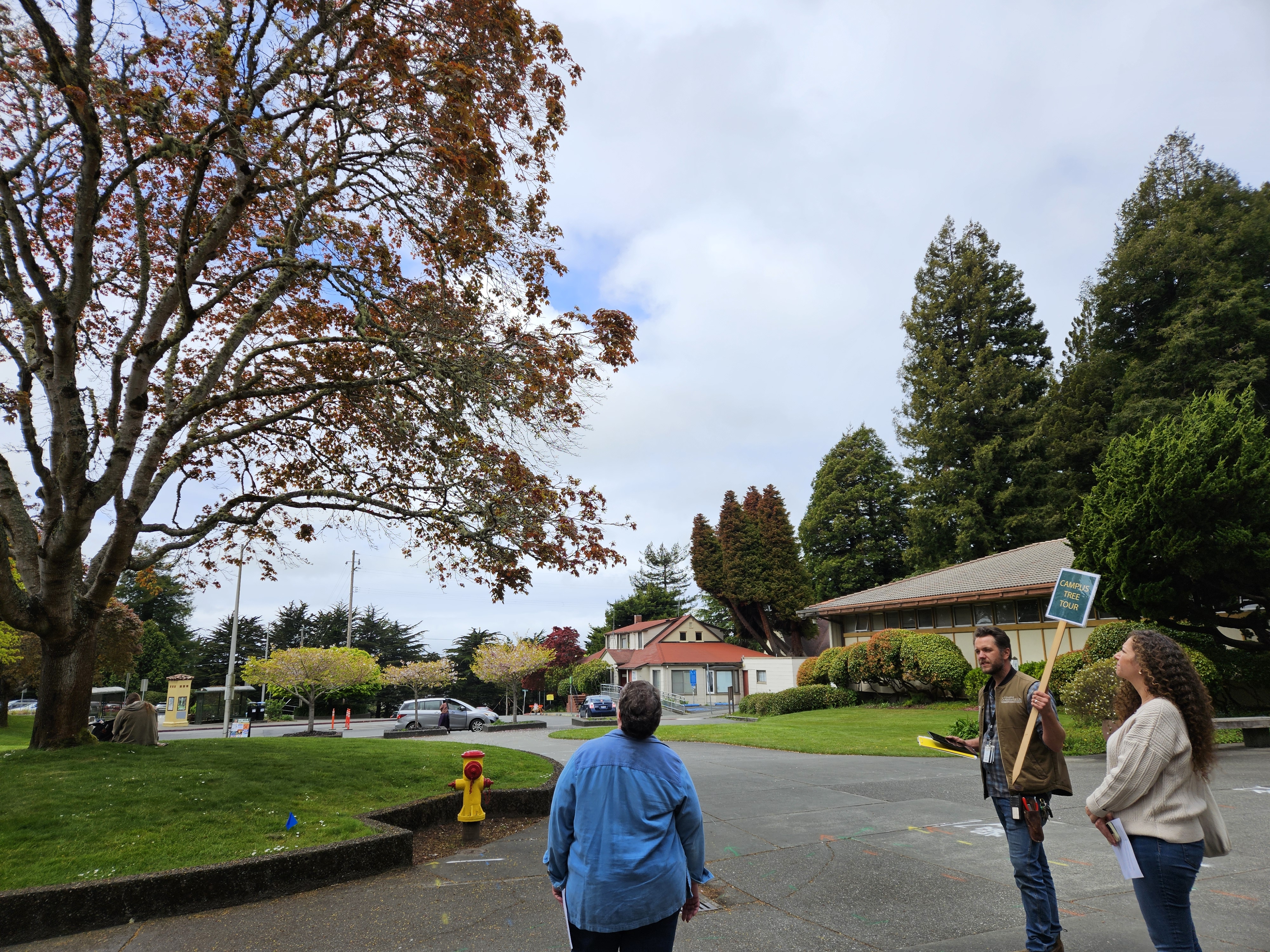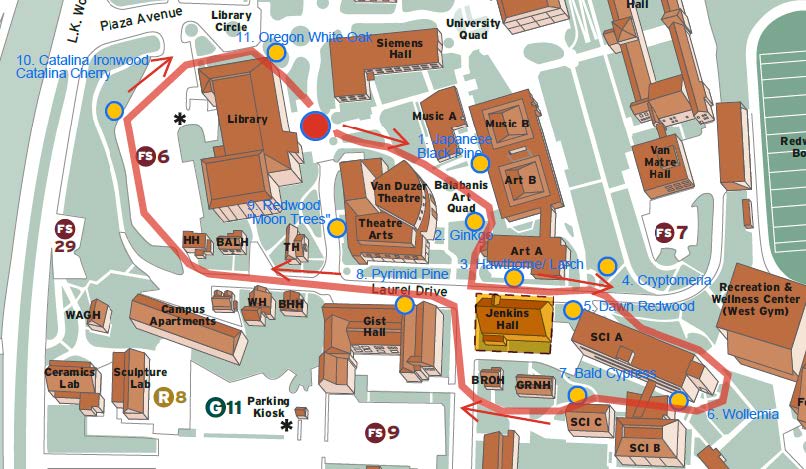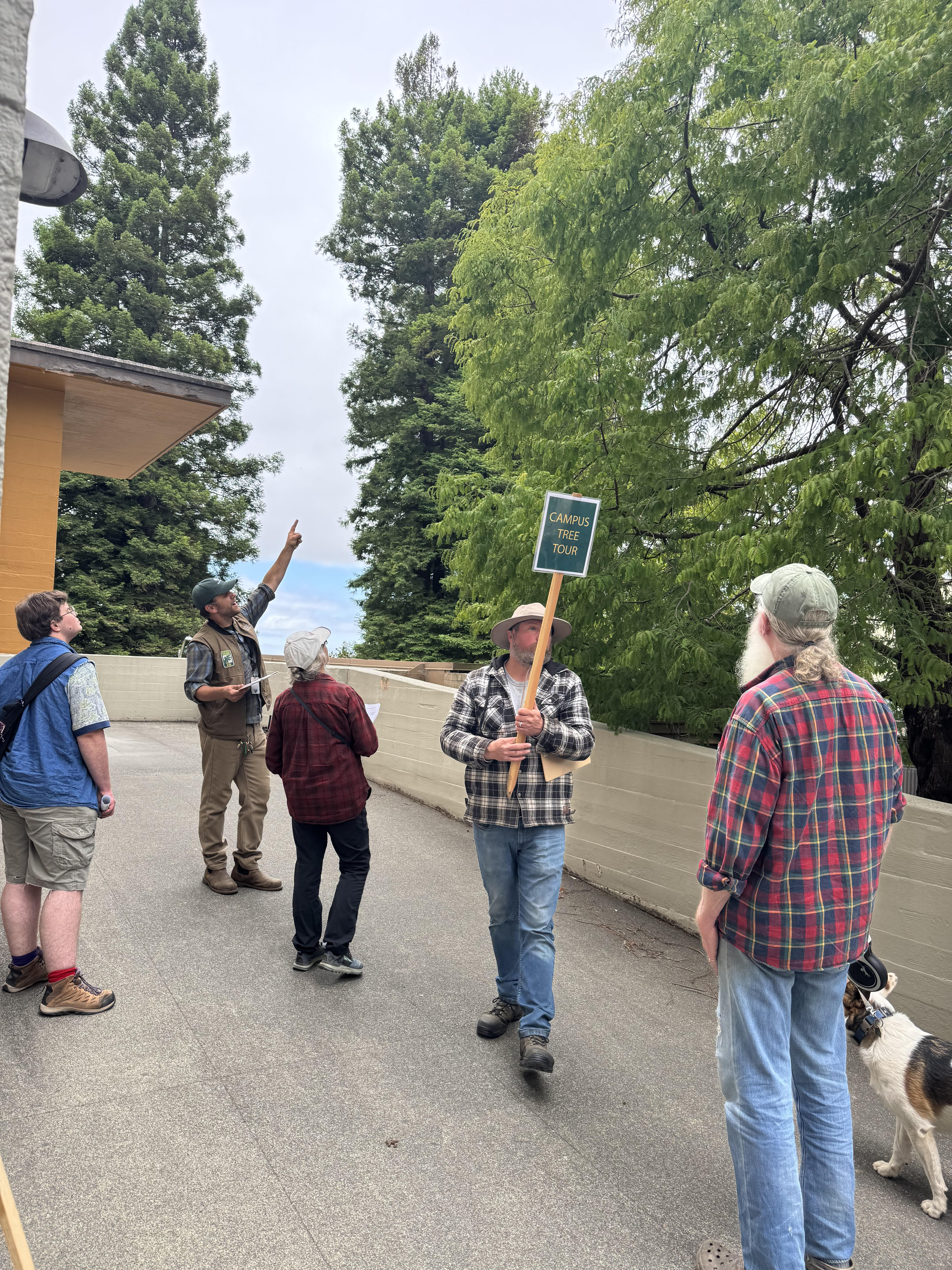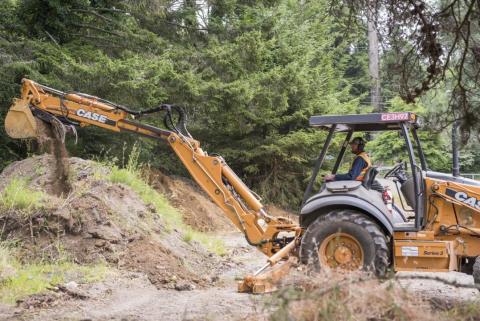Breadcrumb
Grounds
Fall 2025 Campus Tree Walking Tour

Thursday November 13, 2025, 3-4pm
Join us to learn about the unique diversity and importance of trees on our campus! The grounds department invites you to join us for a 1 hour long campus tree walking tour. We will highlight a number of important trees around campus and share fun information and perspectives. Meet us at the Gutswurrak Student Activities quad at 3pm on Thursday Nov 13th. Please be prepared for our erratic Humboldt weather, wear appropriate clothing and comfortable footwear, and consider an umbrella if it seems appropriate.
Meet at the Gutswurrak Student Activities Quad
Brought to you by the Cal Poly Humboldt Grounds Department.
For questions or special accommodations, email fmservice@humboldt.edu
Example tour from previous semesters

- Japanese Black Pine, Pinus thunbergii
- Ginkgo (Maidenhair tree), Ginkgo biloba
- Hawthornes (Crataegus), and Junipers, Weeping European Larch, Larix decidua ‘Pendula’ *
- Dawn Redwood, Metasequoia glyptostroboides
- Japanese Cedar, Cryptomeria japonica.
- Wollemia Pine, Wollemia nobilis
- Bald Cypress, Taxodium distichum
- Vanderwolf’s Pyrimid Limber Pine, Pinus flexsilis ‘Vanderwolf’s Pyrimid’
- Coast Redwood, Sequoia sempervirens, “Moon Trees”
- Catalina Ironwood, Lynothamnus floribundus & Catalina Cherry, Prunus ilicifolia
- Oregon White Oak, Quercus garryana.


Landscape Management
During the Spring 2022 semester, a Senior Environmental Science & Management student (Sara Bandali) took on the task of formally documenting the Landscape Management Plan currently in place on the Cal Poly Humboldt Campus. With the help of the FM Sustainability department, FM Grounds department, and the FM Planning Department. These teams spent many hours pulling together content and formatting to produce this publication. This document may be viewed online here or downloaded as a PDF here. We are excited to have this document to reflect the current point of development for our landscaping practices. These practices will be reviewed annually and updated as needed to accurately reflect current practices in the Cal Poly Humboldt Grounds Shop.
In addition, we completed the first formalized Shared Maintenance and Comanagement Agreement for Outside space allocated to a specific Department and/or Program. The Food Sovereignty Lab & Traditional Ecological Knowledges Institute agreement for space surrounding the Behavioral & Social Sciences Building on the main Cal Poly Humboldt campus may be found here.

Cal Poly Humboldt is a Bee Campus USA Affiliate
Cal Poly Humboldt is working to conserve native pollinators by increasing the number of native plants, adding habitat, providing education and reducing the use of pesticides.
Bee City USA and Bee Campus USA are initiatives of the Xerces Society for Invertebrate Conservation, with a mission to galvanize communities and campuses to sustain pollinators by providing them with healthy habitats. The focus of this program is on native pollinators. And it’s not just about bees! Butterflies, moths, beetles, flies and even hummingbirds are pollinators too!
Who are Our Local Pollinators?
Download the Native Pollinators of Humboldt County catalogue to learn more:
Native Pollinators of Humboldt County >>>
Pollinator Facts
- Pollinators are necessary for nearly 85% of all flowering plants, including the crops that give us one in three bites of the food we eat.
- Pollinators are keystone species in essentially every terrestrial ecosystem on earth, assisting in plant reproduction and supporting other species of wildlife.
- Over 40% of native pollinator species are in decline worldwide, with some at risk of extinction, due to habitat loss, the use of harmful pesticides, disease, and climate change.
- We need pollinators, so we should do all we can to ensure that they have a safe and robust habitat.
- These and other pollinator facts can be found on the Xerces Society website.
Pollinator Map
Hummingbirds, Anise Swallowtail butterflies, and Yellow-faced bumble bees are common native pollinators on the Cal Poly Humboldt campus. While you can see these and other pollinators all over campus, use the map to look for these pollinators at four key locations on campus.
Cal Poly Humboldt Pollinator Map >>>
Integrated Pest Management Plan and Pollinator-friendly Plant List
Cal Poly Humboldt created its integrated Pest Management Plan (IPM) in 2024, designed to prevent pest problems, reduce pesticide use, and expand the use of non-chemical pest management methods. As we reduce our impacts on pollinators, the Grounds Department is also working on developing additional pollinator-friendly areas on campus that utilize native plants. The pollinator garden on the northwest corner of Alistair McCrone Hall (AMH) is just one example.
Integrated Pest Management Plan >>>
AMH Pollinator Garden Plant List >>>
List of Local Suppliers of Native and Pollinator-Friendly Plants >>>
Our Landscape and Tree Advisory Committee serves to provide input to Facilities Management with regard to the planning, design and maintenance functions associated with the University's and Residence Hall landscape and urban forest.





